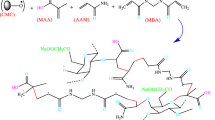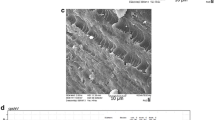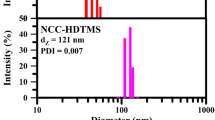Abstract
Carboxymethyl cellulose/poly(acrylic acid) (CMC-cl-pAA) hydrogel and its magnetic hydrogel nanocomposite (CMC-cl-pAA/Fe3O4-C30B) were prepared via a free radical polymerization method and used as adsorbents for adsorption of methylene blue (MB) dye. The samples were characterized using Fourier transform infrared, X-ray diffraction, thermogravimetric analysis, scanning electron microscopy coupled with energy-dispersive X-ray spectrometer, high-resolution transmission electron microscope, and dynamic mechanical analysis. The adsorption performance of the prepared adsorbents was studied in a batch mode. Adsorption kinetics and isotherm models were applied in the experimental data to evaluate the nature as well as the mechanism of adsorption processes. It was deduced that the adsorption followed the pseudo-second-order rate equation and Langmuir isotherm models. The maximum adsorption capacities were found to be 1109.55 and 1081.60 mg/g for CMC-cl-pAA hydrogel and CMC-cl-pAA/Fe3O4-C30B hydrogel nanocomposite, respectively. The adsorption thermodynamic studies suggested that the adsorption process was spontaneous and endothermic for CMC-cl-pAA/Fe3O4-C30B hydrogel nanocomposite. The homogeneous dispersion of the Fe3O4-C30B nanocomposite in the CMC-cl-pAA hydrogel significantly improved the thermal stability, mechanical strength, and excellent regeneration stability. This study demonstrates the application potential of the fascinating properties of CMC-cl-pAA/Fe3O4-C30B hydrogel nanocomposite as a highly efficient adsorbent in the removal of organic dyes from aqueous solution.









Similar content being viewed by others
References
Abreu AS, Oliveira M, Machado AV (2015) Effect of clay mineral addition on properties of bio-based polymer blends. Appl Clay Sci 104:277–285
Acp CMC, Tooth V, Caries D, Chen Z, Cao S, Wang H, Deng X (2015) Remineralization of demineralized dentine using scaffold of CMC/ACP nanocomplexes in an in vitro tooth model of deep caries. PLoS One 10:e0116553
Adegoke KA, Bello OS (2015) Dye sequestration using agricultural wastes as adsorbents. Water Resources and Industry 12:8–24
Atta A, Akl MA, Youssef AM, Ibraheim MA (2013) Superparamagnetic core-shell polymeric nanocomposites for efficient removal of methylene blue from aqueous solutions. Adsorpt Sci Technol 31:397–419
Bao Y, Ma J, Li N (2011) Synthesis and swelling behaviours of sodium carboxymethyl cellulose-g-poly(AA-co-AM-co-AMPS)/MMT superabsorbent hydrogel. Carbohydr Polym 84:76–82
Benhalima T, Ferfera-Harrar H, Lerari D (2017) Optimization of carboxymethyl cellulose hydrogels beads generated by an anionic surfactant micelle templating for cationic dye uptake: swelling, sorption and reusability studies. Int J Biol Macromol 105:1025–1042
Boumediene M, Benaïssa H, George B, Molina S, Merlin A (2018) Effects of pH and ionic strength on methylene blue removal from synthetic aqueous solutions by sorption onto an orange peel and desorp tion study. J Mater Environ Sci 9:1700–1711
Capanema NSV, Mansur AAP, Mansur HS, de Jesus AC, Carvalho SM, Chagas P, de Oliveira LC (2018) Eco-friendly and biocompatible cross-linked carboxymethylcellulose hydrogels as adsorbents for the removal of organic dye pollutants for environmental applications. Environ Technol 39:2856–2872
Cheng J, Shi L, Lu J (2016) Amino ionic liquids-modified magnetic core/shell nanocomposite as an efficient adsorbent for dye removal. J Ind Eng Chem 36:206–214
Chin SF, Iyer KS, Raston CL (2008) Fabrication of carbon-nanotubes decorated with ultra-fine super magnetic nano-particles under continuous flow conditions. RSC, Lab Chip 8:439–442
Dai H, Huang Y, Huang H (2018) Eco-friendly polyvinyl alcohol/carboxymethyl cellulose hydrogels reinforced with graphene oxide and bentonite for enhanced adsorption of methylene blue. Carbohydr Polym 185:1–11
De Gisi S, Lofrano G, Grassi M, Notarnicola M (2016) Characteristics and adsorption capacities of low-cost sorbents for wastewater treatment: a review. Sustain Mater Technol 9:10–40
Deen GR, Chua V (2015) Synthesis and properties of new “stimuli” responsive nanocomposite hydrogels containing silver nanoparticles. Gels 1:117–134
Dogan M, Karaoglu MH, Alkan M (2009) Adsorption kinetics of maxilon yellow 4GL and maxilon red GRL dyes on kaolinite. J Hazard Mater 165:1142–1151
Fekete T, Borsa J, Takács E, Wojnárovits L (2016) Synthesis of cellulose-based superabsorbent hydrogels by high-energy irradiation in the presence of a crosslinking agent. Radiat Phys Chem 118:114–119
Gao H, Rao J, Guan YW, Li W, Zhang M, Shu T, Lv Z (2018) Investigation of the thermo-mechanical properties of blend films based on hemicelluloses and cellulose. International Journal of Polymer Science 2018:1–10
Geçgel U, Üner O, Gökara G, Bayrak Y (2016) Adsorption of cationic dyes on activated carbon obtained from waste Elaeagnus stone. Adsorpt Sci Technol 34:512–525
Godiya CB, Cheng X, Li D, Chen Z, Lu X (2018) Carboxymethyl cellulose/polyacrylamide composite hydrogel for cascaded treatment/reuse of heavy metal ions in wastewater carboxymethyl cellulose/polyacrylamide composite hydrogel for cascaded treatment/reuse of heavy metal ions in wastewater. J Hazard Mater 364:28–38
Hato MJ, Sinha Ray S, Luyt AS (2008) Nanocomposites based on polyethylene and polyhedral oligomeric silsesquioxanes, 1-microstructure, thermal and thermomechanical properties. Macromol Mater Eng 293:752–762
Hato MJ, Zhang K, Ray SS, Choi HJ (2011) Rheology of organoclay suspension. Colloid Polym Sci 289:1119–1125
Hoffman AS (2012) Hydrogels for biomedical applications. Adv Drug Deliv Rev 64:18–23
Hosseinzadeh H, Khoshnood N (2016) Removal of cationic dyes by poly (AA-co-AMPS)/montmorillonite nanocomposite hydrogel. Desalin Water Treat 57:1–12
Hu X-S, Liang R, Sun G (2018) Super-adsorbent hydrogel for removal of methylene blue dye from aqueous solution. J Mater Chem A 6:17612–17624
Khedmat S, Momen-Heravi F, Pishvaei M (2013) A comparison of viscoelastic properties of three root canal sealers. J Dent 10:147–154
Kono H (2014) Characterization and properties of carboxymethyl cellulose hydrogels crosslinked by polyethylene glycol. Carbohydr Polym 106:84–93
Li X, Rombouts W, van der Gucht J, de Vries J, Dijksman JA (2019) Mechanics of composite hydrogels approaching phase separation. PLoS One 14:e0211059
Lin O, Gao M, Chang J, Ma H (2017) Highly effective adsorption performance of carboxymethyl cellulose microspheres crosslinked with epichlorohydrin. J Appl Polym Sci 134:44363
Liu C, Zhou Y, Nie W, Song L, Chen P (2015) Fabrication of hydrogel of hydroxypropyl cellulose (HPC) composited with graphene oxide and its application for methylene blue removal. J Mater Sci 50:6113–6123
Liu C, Omer AM, Ouyang X (2018) Adsorptive removal of cationic methylene blue dye using carboxymethyl cellulose/k-carrageenan/activated montmorillonite composite beads: isotherm and kinetic studies. Int J Biol Macromol 106:823–833
Loh KS, Lee YH, Musa A, Salmah AA, Zamri I (2008) Use of Fe3O4 nanoparticles for enhancement of biosensor response to the herbicide 2,4-dichlorophenoxyacetic acid. Sensors 8:5775–5791
Magdy A, Fouad YO, Abdel-Aziz MH, Konsowa AH (2017) Synthesis and characterization of Fe3O4/kaolin magnetic nanocomposite and its application in wastewater treatment. J Ind Eng Chem 56:299–311
Mahdavinia G, Afzali A, Etemadi H, Hosseinzadeh H (2017) Magnetic/pH-sensitive nanocomposite hydrogel based carboxymethyl cellulose-g-polyacrylamide/montmorillonite for colon targeted drug delivery. Nanomed Res J 2:111–122
Mahmoodi NM, Hayati B, Arami M (2012) Kinetic, equilibrium and thermodynamic studies of ternary system dye removal using a biopolymer. Ind Crop Prod 35:295–301
Makhado E, Ray SS (2015) Mechanical, Barrier and antimicrobial properties of biodegradable poly (ε-caprolactone) nanocomposites. Advanced Science, Engineering and Medicine 7:351–360
Makhado E, Pandey S, Nomngongo PN, Ramontja J (2018a) Preparation and characterization of xanthan gum-cl-poly (acrylic acid)/o-MWCNTs hydrogel nanocomposite as a highly effective reusable adsorbent for removal of methylene blue from aqueous solutions. J Colloid Interface Sci 513:700–714
Makhado E, Pandey S, Ramontja J (2018b) Microwave-assisted synthesis of xanthan gum-cl-poly (acrylic acid) based-reduced graphene oxide hydrogel composite for adsorption of methylene blue and methyl violet from aqueous solution. Int J Biol Macromol 119:255–269
Makhado E, Pandey S, Kang K, Fosso-Kanke E (2019a) Microwave-assisted synthesis of xanthan gum-cl-dimethyl acrylamide hydrogel-based silica hydrogel as adsorbent for cadmium (II) removal. Int’l Conference on Science, Engineering, Technology & Waste Management (SETWM-19), 1, 1–6
Makhado E, Pandey S, Nomngongo PN, Ramontja J (2019b) New horizons in wastewaters management: emerging monitoring and remediation. Hydrogel Nanocomposites: Innovations in Nanotechnology for Water Treatment, Nova Science Publishers, (Chapter 5).
Makhado E, Pandey S, Ramontja J (2019c) Microwave-assisted green synthesis of xanthan gum grafted diethylamino ethyl methacrylate: efficient adsorption of hexavalent chromium. Carbohydr Polym 222:114989
Makhado E, Pandey S, Modibane KD, Kang M, Hato MJ (2020) Sequestration of methylene blue dye using sodium alginate poly (acrylic acid)@ ZnO hydrogel nanocomposite: kinetic, isotherm, and thermodynamic investigations. Int J Biol Macromol 162:60–73
Maponya TC, Ramohlola KE, Kera NH, Modibane KD, Maity A, Katata-Seru LM, Hato MJ (2020) Influence of magnetic nanoparticles on modified polypyrrole/m-phenylenediamine for adsorption of Cr(VI) from aqueous solution. Polymers 12:679–695
Melo BC, Paulino FAA, Cardoso VA, Pereira AGB, Fajardo AR, Rodrigues FH (2018) Cellulose nanowhiskers improve the methylene blue adsorption capacity of chitosan-g-poly (acrylic acid) hydrogel. Carbohydr Polym 181:358–367
Mishra S, Mukul A, Sen G, Jha U (2011) (2011). Microwave-assisted synthesis of polyacrylamide grafted starch (St-g-PAM) and its applicability as flocculant for water treatment. Int J Biol Macromol 48:106–111
Mittal H, Ray SS (2016) A study on the adsorption of methylene blue onto gum ghatti/TiO2 nanoparticles-based hydrogel nanocomposite. Int J Biol Macromol 88:66–80
Mittal H, Parashar V, Mishra SB, Mishra AK (2014) Fe3O4 MNPs and gum xanthan based hydrogels nanocomposites for the efficient capture of malachite green from aqueous solution. Chem Eng J 255:471–482
Mittal H, Kumar V, Saruchi, Ray SS (2016) Adsorption of methyl violet from aqueous solution using gum xanthan/Fe3O4 based nanocomposite hydrogel. Int J Biol Macromol 89:1–11
Ninan N, Muthiah M, Park IK, Elain A, Thomas S, Grohens Y (2013) Pectin/carboxymethyl cellulose/microfibrillated cellulose composite scaffolds for tissue engineering. Carbohydr Polym 98:877–885
Peng N, Hu D, Zeng J, Li Y, Liang L, Chang C (2016) Superabsorbent cellulose−clay nanocomposite hydrogels for highly efficient removal of dye in water. ACS Sustain Chem Eng 4:7217–7224
Salama A (2015) Carboxymethyl cellulose-g-poly (acrylic acid)/calcium phosphate composite as a multifunctional hydrogel material. Mater Lett 157:243–247
Salama A (2018) Preparation of CMC-g-P(SPMA) super adsorbent hydrogels: exploring their capacity for MB removal from wastewater. Int J Biol Macromol 106:940–946
Shen J, Cui C, Li J, Wang L (2018) In situ synthesis of a silver-containing superabsorbent polymer via a greener method based on carboxymethyl celluloses. Molecules 23:2483
Shi Y, Xue Z, Wang X, Wang AQ (2013) Removal of methylene blue from aqueous solution by sorption on lignocellulose-g-poly (acrylic acid)/montmorillonite three-dimensional cross-linked polymeric network hydrogels. Polym Bull 70:1163–1179
Sitthichai S, Pilapong C, Thongtem T (2015) CMC-coated Fe3O4 nanoparticles as new MRI probes for hepatocellular carcinoma. Appl Surf Sci 356:972–977
Soliman FM, Yang W, Guo H, Shinger ML, Idris AM, Hassan ES (2016) Preparation of carboxymethyl cellulose-g-poly (acrylic acid-2-acrylamido-2-methylpropane sulfonic acid)/attapulgite superabsorbent composite. J Polym Sci 2:11–19
Song W, Gao B, Xu X, Xing L, Han S, Dua P, Song W, Jia R (2016) Adsorption–desorption behaviour of magnetic amine/Fe3O4 functionalized biopolymer resin towards anionic dyes from wastewater. Bioresour Technol 210:123–130
Soppiranth KS, Aminabhavi TM (2002) Water transport and drug release study from a cross-linked polyacrylamide grafted guar gum hydrogel microspheres for the controlled release application. Eur J Pharm Biopharm 53:87–98
Su H, Li W, Han Y, Liu N (2018) Magnetic carboxyl functional nanoporous polymer: synthesis, characterization and its application for methylene blue adsorption. Sci Rep 8:1–8
Sulistiyo YA, Andriana N, Piluharto B, Zulfikar Z (2017) Silica gels from coal fly ash as methylene blue adsorbent: isotherm and kinetic studies. Bull Chem React Eng Catal 12:263–272
Sun X, Liu B, Jing Z, Wang H (2015) Preparation and adsorption property of xylan/poly (acrylic acid) magnetic nanocomposite hydrogel adsorbent. Carbohydr Polym 118:16–23
Thakur S, Pandey S, Arotiba OA (2016) Development of a sodium alginate-based organic/inorganic superabsorbent composite hydrogel for adsorption of methylene blue. Carbohydr Polym 153:34–46
Toor AT, Verma A, Jotshi CK, Bajpai PK, Singh V (2006) Photocatalytic degradation of Direct Yellow 12 dye using UV/TiO2 in a shallow pond slurry reactor. Dyes Pigm 68:53–60
Wang Z, Ning A, Xie P, Gao G, Xie L, Li X (2018) Synthesis and swelling behaviours of carboxymethyl cellulose-based superabsorbent resin hybridized with graphene oxide. Carbohydr Polym 157:48–56
Wittenberg E, Meyer A, Eggers S, Abetz V (2018) Hydrogen bonding and thermoplastic elastomers–a nice couple with temperature-adjustable mechanical properties. Royal Society of Chemistry. Soft Matter 14:2701–2711
Xu J, Zhang F, Sun J, Sheng J, Wang F, Sun M (2014) Bio and nanomaterials based on Fe3O4. Molecules 19:21506–21528
Yadav M, Rhee KY, Jung IH, Park SJ (2013) Eco-friendly synthesis, characterization and properties of a sodium carboxymethyl cellulose/graphene oxide nanocomposite film. Cellulose 20:687–698
Yagub MT, Sen TK, Afroze S, Ang HM (2014) Dye and its removal from aqueous solution by adsorption. Adv Colloid Interf Sci 209:172–184
Yue Y, Wang X, Wu Q, Han J (2019) Assembly of polyacrylamide-sodium alginate-based organic-inorganic hydrogel with mechanical and adsorption properties. Polymer 11:1239
Zhang G, Yi L, Deng H, Sun P (2014) Dyes adsorption using a synthetic carboxymethyl cellulose-acrylic acid adsorbent. J Environ Sci 26:1203–1211
Zhao L, Yang S (2017) Preparation and application of carboxylated graphene oxide sponge in dye removal. Int J Environ Res Public Health 14:1301
Zhu L, Qiu J, Sakai E (2017) A high modulus hydrogel obtained from hydrogen bond reconstruction and its application in vibration damper. Royal Society of Chemistry Advances 7:43755–43763
Acknowledgements
M.J. Hato is grateful to the Sasol Inzalo Foundation of South Africa for procuring both STA and UV-vis instruments.
Funding
This research was supported by the National Research Foundation (NRF) under the Thuthuka programme (UIDs. 117727, and 118113), NRF postdoctoral fellowship (UID. 116679), and University of Limpopo (Q313, R202, R232, R355), South Africa.
Author information
Authors and Affiliations
Corresponding authors
Ethics declarations
Conflict of interest
The authors declare that they have no competing interests.
Additional information
Responsible Editor: Angeles Blanco
Publisher’s note
Springer Nature remains neutral with regard to jurisdictional claims in published maps and institutional affiliations.
Electronic supplementary material
ESM 1
(DOCX 1130 kb)
Rights and permissions
About this article
Cite this article
Malatji, N., Makhado, E., Ramohlola, K.E. et al. Synthesis and characterization of magnetic clay-based carboxymethyl cellulose-acrylic acid hydrogel nanocomposite for methylene blue dye removal from aqueous solution. Environ Sci Pollut Res 27, 44089–44105 (2020). https://doi.org/10.1007/s11356-020-10166-8
Received:
Accepted:
Published:
Issue Date:
DOI: https://doi.org/10.1007/s11356-020-10166-8




